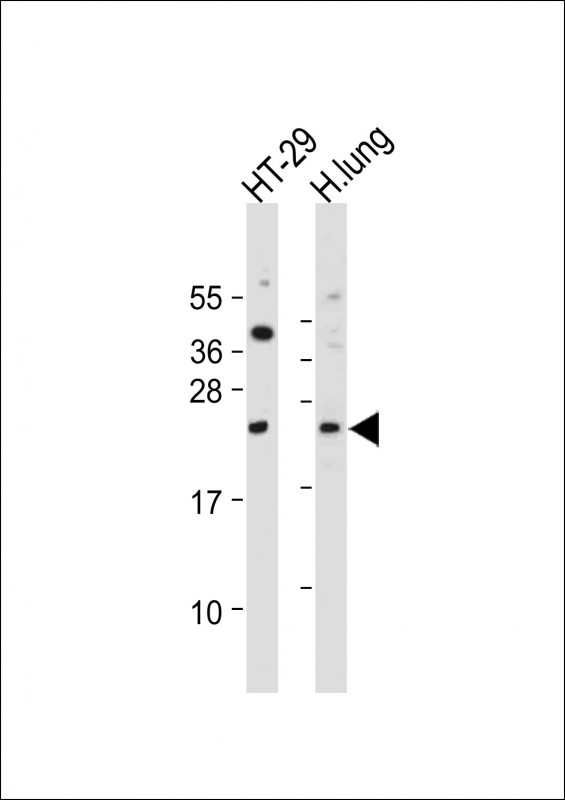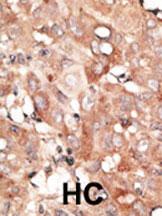RGS19 Antibody (N-term)
Purified Rabbit Polyclonal Antibody (Pab)
- 产品详情
- 文献引用 : 2
- 实验流程
- 背景知识
Application
| IHC-P, WB, E |
|---|---|
| Primary Accession | P49795 |
| Reactivity | Human, Rat, Mouse |
| Host | Rabbit |
| Clonality | Polyclonal |
| Isotype | Rabbit IgG |
| Calculated MW | 24636 Da |
| Antigen Region | 1-30 aa |
| Gene ID | 10287 |
|---|---|
| Other Names | Regulator of G-protein signaling 19, RGS19, G-alpha-interacting protein, GAIP, RGS19, GAIP, GNAI3IP |
| Target/Specificity | This RGS19 antibody is generated from rabbits immunized with a KLH conjugated synthetic peptide between 1~30 amino acids from the N-term of human RGS19. |
| Dilution | IHC-P~~1:100~500 WB~~1:2000 E~~Use at an assay dependent concentration. |
| Format | Purified polyclonal antibody supplied in PBS with 0.09% (W/V) sodium azide. This antibody is prepared by Saturated Ammonium Sulfate (SAS) precipitation followed by dialysis against PBS. |
| Storage | Maintain refrigerated at 2-8°C for up to 2 weeks. For long term storage store at -20°C in small aliquots to prevent freeze-thaw cycles. |
| Precautions | RGS19 Antibody (N-term) is for research use only and not for use in diagnostic or therapeutic procedures. |
| Name | RGS19 |
|---|---|
| Synonyms | GAIP, GNAI3IP |
| Function | Inhibits signal transduction by increasing the GTPase activity of G protein alpha subunits thereby driving them into their inactive GDP-bound form. Binds to G-alpha subfamily 1 members, with the order G(i)a3 > G(i)a1 > G(o)a >> G(z)a/G(i)a2. Activity on G(z)-alpha is inhibited by phosphorylation and palmitoylation of the G-protein. |
| Cellular Location | Membrane; Lipid-anchor. |
| Tissue Location | Highest expression in lung. Placenta, liver and heart also express high levels of GAIP |
For Research Use Only. Not For Use In Diagnostic Procedures.

Provided below are standard protocols that you may find useful for product applications.
BACKGROUND
Macroautophagy is the major inducible pathway for the general turnover of cytoplasmic constituents in eukaryotic cells, it is also responsible for the degradation of active cytoplasmic enzymes and organelles during nutrient starvation. Macroautophagy involves the formation of double-membrane bound autophagosomes which enclose the cytoplasmic constituent targeted for degradation in a membrane bound structure, which then fuse with the lysosome (or vacuole) releasing a single-membrane bound autophagic bodies which are then degraded within the lysosome (or vacuole). RGS19 enhances the intrinsic GTPase-activating protein activity of the Galphai3 protein, which stimulates autophagy by favoring the GDP-bound form of Galphai3.
REFERENCES
Baehrecke EH. Nat Rev Mol Cell Biol. 6(6):505-10. (2005)
Lum JJ, et al. Nat Rev Mol Cell Biol. 6(6):439-48. (2005)
Greenberg JT. Dev Cell. 8(6):799-801. (2005)
Levine B. Cell. 120(2):159-62. (2005)
Shintani T and Klionsky DJ. Science. 306(5698):990-5. (2004)
de Vries L., et al. PNAS 93:15203-15208(1996)
de Alba E., et al. J. Mol. Biol. 291:927-939(1999)
Wang J., et al. J. Biol. Chem. 273:26014-26025(1998)
Ogier-Denis E., et al. J. Biol. Chem. 275:39090-39095(2000)
终于等到您。ABCEPTA(百远生物)抗体产品。
点击下方“我要评价 ”按钮提交您的反馈信息,您的反馈和评价是我们最宝贵的财富之一,
我们将在1-3个工作日内处理您的反馈信息。
如有疑问,联系:0512-88856768 tech-china@abcepta.com.






















 癌症的基本特征包括细胞增殖、血管生成、迁移、凋亡逃避机制和细胞永生等。找到癌症发生过程中这些通路的关键标记物和对应的抗体用于检测至关重要。
癌症的基本特征包括细胞增殖、血管生成、迁移、凋亡逃避机制和细胞永生等。找到癌症发生过程中这些通路的关键标记物和对应的抗体用于检测至关重要。 为您推荐一个泛素化位点预测神器——泛素化分析工具,可以为您的蛋白的泛素化位点作出预测和评分。
为您推荐一个泛素化位点预测神器——泛素化分析工具,可以为您的蛋白的泛素化位点作出预测和评分。 细胞自噬受体图形绘图工具为你的蛋白的细胞受体结合位点作出预测和评分,识别结合到自噬通路中的蛋白是非常重要的,便于让我们理解自噬在正常生理、病理过程中的作用,如发育、细胞分化、神经退化性疾病、压力条件下、感染和癌症。
细胞自噬受体图形绘图工具为你的蛋白的细胞受体结合位点作出预测和评分,识别结合到自噬通路中的蛋白是非常重要的,便于让我们理解自噬在正常生理、病理过程中的作用,如发育、细胞分化、神经退化性疾病、压力条件下、感染和癌症。







